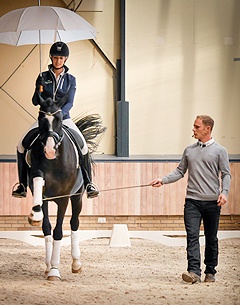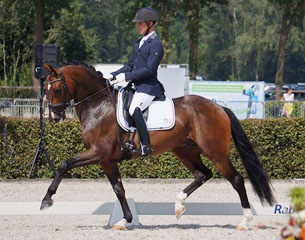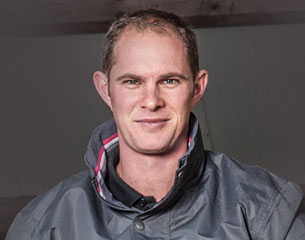
As breeding in the top sport of dressage has progressed, we have moved more and more into creating a Ferrari type sport horse that is more athletic, more powerful and expressive. But along with that also comes more sensitive and electric type characters. The more sensitive character demands a higher level of technical skill from the rider, but in some instances ends up in a struggle against the higher natural instinct of survival, that is now part of the breeding process in our modern day dressage horses.
According to dressage trainer and horseman Tristan Tucker, there is a level of natural sensitivity in our modern day sport horses that, no matter how good the technical level of the rider or the level of physical control over the horse, there are situations and environments where a horse's fear over rides it.
Tristan: "We just need to better prepare our horses for the things we ask of them. It’s a lack of preparation and an instillation of knowledge into the horse about what he has to do and how he can control himself that leads to moments where things go wrong.”
Tristan believes that there needs to be more focus on the horse knowing how to cope better with the environments and pressures of being a sport horse. An education he explains as the horse’s knowledge of a human environment.
"Everything you want to do with the horse is like an exam. If you have not given the right information about what he's about to experience and what kind of things he will be asked in the exam, you and your horse will be forced to fail."
There are images circulating in the media in bad light critical of some riders. Were these horses unprepared?
“I think these are moments of natural occurring events. Some horses are getting tense from a show atmosphere, so riders try to use their best technical skills of riding to relax and control their horses. If there are noises or movements in the environment that would from nature scare a horse, then naturally he uses flight and tries to escape the situation. Naturally, the rider tries to control his horse to avoid a worse situation. In these moments, long or short, there are photos taken and stories made.”
 Tristan says he tries to avoid these situations by teaching his horses with ground work how to respond to the flight inducing pressures at the shows. Why do you think ground work is not a popular practice with most dressage riders?
Tristan says he tries to avoid these situations by teaching his horses with ground work how to respond to the flight inducing pressures at the shows. Why do you think ground work is not a popular practice with most dressage riders?
“I think because ground work, apart from some lunging, is not something that traditionally was ever taught as a rider. And to start with it, it brings riders from the saddle to the ground and out of their comfort zone.”
I find horses learn through body language and on the ground they can see all of my body and I can see all of them and it is a way the horse can learn without the distraction or added pressure of the rider.
Tristan says his aim is to not desensitize the horses and make them quiet but to teach the horse a technique or concept that is useful to them in knowing how to control and relax themselves in moments and situations that would naturally cause tension in the horse.
In the ground work Tristan teaches the horse through a three step program called the TRT Method ground work exercises that creates patterns in the body to relieve tension. These are patterns Tristan says create a physical posture in the horse that he chooses to relax himself, or like he also calls it: ‘yoga for horses.’
"Horses have the ability to make the right choices in a moment of pressure, but they have to have two things to choose from otherwise they only have flight. In the end the horse always chooses the relaxed posture because that's the one he feels comfort and confidence in and if the horse is controlling himself and his own tension this job is relieved from the rider.”
The common things at the shows that often create tension is horses, the judges boxes, flags, umbrellas, press cameras etc. is also a focal point in Tristan's method.
“I try not to desensitize the horses to objects by exposing them over and over, but I try to teach the horses a concept of how to control their physical action in the moment they feel the presence of such objects. I found that desensitizing the horse "gets them used" to that particular object but becomes more scared when he sees something new that is not the object he was trained with.”
 Tristan exposes the horses in the ground work to certain objects and tries to influence the horse to take a relaxed physical action in the presence of the scary object with elements of pressure that involve movement, touch and sound. All the elements he says influence the horse the most in a competition environment.
Tristan exposes the horses in the ground work to certain objects and tries to influence the horse to take a relaxed physical action in the presence of the scary object with elements of pressure that involve movement, touch and sound. All the elements he says influence the horse the most in a competition environment.
“With my method, I try to make a bridge between groundwork and dressage to give horses the best
chance to perform with confidence, and my riders to ride without stress.”
Since his wowing demonstration at the Global Dressage Forum three years ago, Tristan gets a lot of requests for training and giving demonstrations all over the world. Because it’s impossible to meet the demands, he has recently launched a new website where dressage riders can sign up for his online training.
“It’s nice when you can help someone in a one-on-one training, but it’s even better when you can reach riders all over the world who don’t have the possibility to come and train with you.“
For more information about Tristan’s training program, visit www.trtmethod.com
Related Links
Tristan Tucker Training the Modern Day Dressage Athlete
Defining Dressage: the Fastest in the Race, or Just Going Round in Circles?
Classical Training: The Piaffe - Placer et Laissez Faire